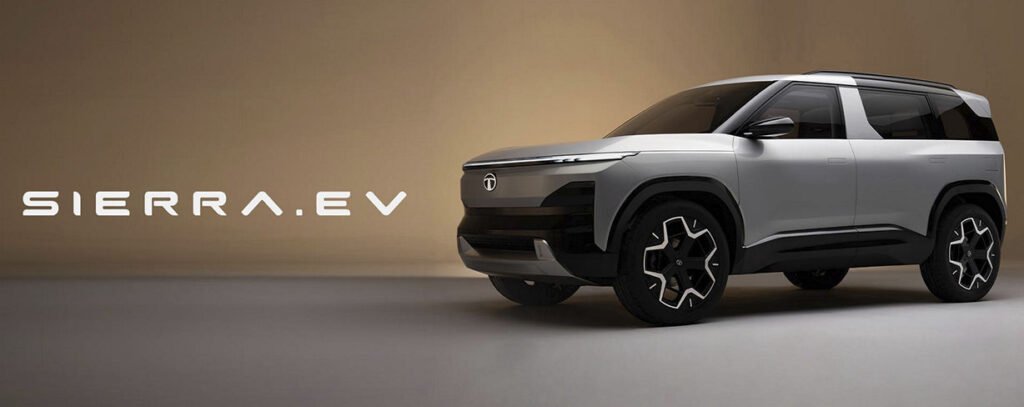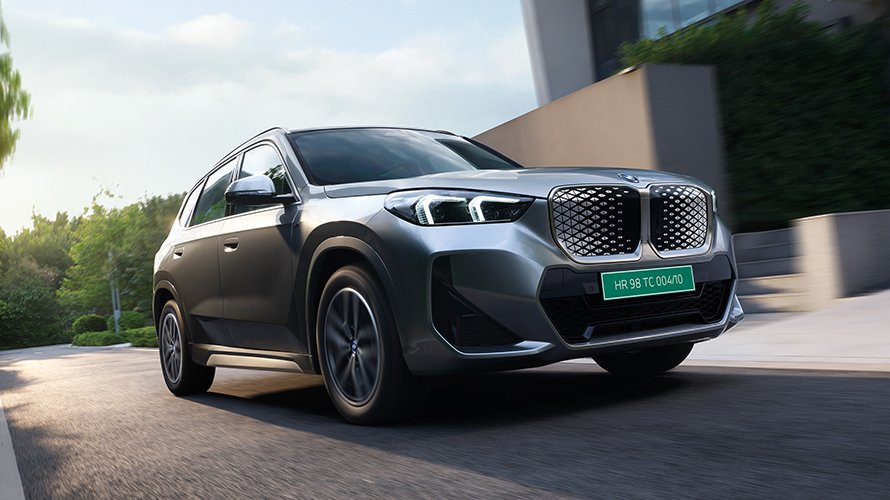Tata Motors is set to revive one of its most beloved icons with the launch of the Sierra EV by the end of 2025, marking a significant push in the premium electric SUV segment. First unveiled in pre-production guise at the Bharat Mobility Global Expo 2025 earlier this year, the Sierra EV embodies a blend of nostalgic design cues from the original 1991 Sierra—India’s pioneering homegrown SUV—and cutting-edge electric technology. Priced between ₹25-30 lakh (ex-showroom), the Sierra EV will slot above the Curvv EV and Harrier EV in Tata’s lineup, directly rivaling the Hyundai Creta EV (launched at ₹17.99-23.50 lakh) and the upcoming Maruti e-Vitara (expected ₹17-22.50 lakh, launch September 3, 2025). With deliveries slated to commence around Diwali 2025, the Sierra EV follows Tata’s EV-first strategy, preceding the ICE variants (petrol/diesel) in early 2026.
The Sierra EV’s revival taps into strong brand recall while addressing the growing demand for sustainable mobility. Tata’s investor presentations confirm the second-half 2025 timeline, built on the Gen2 acti.ev platform shared with the Punch EV and Curvv EV. This midsize electric SUV promises up to 500 km of real-world range, advanced Level 2 ADAS, and a segment-first floating triple-screen setup, positioning it as a tech-forward contender in a market where EV sales surged 40% year-on-year in 2025. As India aims for 30% EV penetration by 2030, the Sierra EV could help Tata maintain its 60%+ market share in passenger EVs. Here’s a comprehensive breakdown of what to expect from this electric icon.
Design: Retro-Futuristic Appeal with Modern SUV Stance
The Sierra EV retains the boxy, upright silhouette of its 1990s predecessor but evolves into a contemporary midsize SUV measuring approximately 4.3-4.4 meters in length, with a wheelbase around 2,600 mm for spacious interiors. Spy images and expo displays reveal a bold front fascia with slim LED headlamps, a closed grille for aerodynamics, and prominent LED DRLs forming a distinctive light bar. The side profile features muscular wheel arches, roof rails, and 18-20 inch diamond-cut alloys wrapped in 245-section tires, emphasizing its planted stance. Blacked-out C-pillars and wraparound rear windows pay homage to the original, while flush door handles and gloss black cladding add premium flair.
At the rear, connected LED taillamps span the width, complemented by a chunky bumper and faux skid plate for a rugged look. Color options include vibrant hues like Cosmic Gold and dual-tones, with EV-specific badges and lime green accents on brake calipers. Ground clearance is expected at 200 mm, suitable for urban and light off-road use. Compared to rivals, the Sierra EV’s taller, more imposing design (height ~1,680 mm) gives it a commanding presence over the sleeker Creta EV (1,635 mm) and e-Vitara (1,635 mm), appealing to buyers seeking a “lifestyle” SUV.
Interior and Features:
Tech-Laden Cabin with Lounge OptionsStep inside the Sierra EV, and you’re greeted by a premium, dual-tone cabin with soft-touch materials, ambient lighting, and a four-spoke steering wheel featuring an illuminated Tata logo. The standout is the massive floating triple 12.3-inch screen setup: a digital driver’s display, central infotainment touchscreen, and dedicated passenger-side unit— a first for Tata and a segment highlight. Powered by the iRA connected car tech, it supports wireless Android Auto/Apple CarPlay, OTA updates, and voice commands via Hey Tata.
Comfort features abound: panoramic sunroof, ventilated front seats (with 8-way power adjustment for the driver), wireless charger, powered tailgate, and a Harman Kardon 9-speaker system. Rear seats offer sliding/reclining functionality with ventilation in higher trims, and a unique 4-seater “lounge” variant provides business-class recliners with ottomans, foldable trays, and individual screens—ideal for chauffeur-driven buyers. Boot space is generous at ~500 liters, expandable to 1,200 liters, with a frunk for EV essentials.
The Sierra EV borrows from the Harrier EV for modern touches like a touch-based HVAC panel and cooled glovebox. In a market where features drive sales, the Sierra EV edges out the Creta EV’s dual 10.25-inch screens and the e-Vitara’s 10.1-inch setup with its innovative triple-display and lounge option.
Powertrain and Performance: Efficient and Capable Electric Drivetrain
Underpinned by Tata’s acti.ev Gen2 architecture, the Sierra EV offers two battery packs: 65 kWh (RWD, ~450-500 km range) and 75 kWh (RWD or AWD, up to 550 km claimed MIDC range). The single-motor RWD setup delivers ~238 bhp and 504 Nm, with 0-100 km/h in ~7.9 seconds and a top speed of 160 km/h. The dual-motor AWD variant boosts to 313 bhp for enhanced traction, ideal for varied Indian terrains.
Charging is practical: 10-80% in 58 minutes via 120 kW DC fast charger, or full charge in 10-12 hours with an 11 kW AC wallbox. It includes V2L (Vehicle-to-Load) for powering appliances and V2V (Vehicle-to-Vehicle) for emergency sharing—features shared with the Harrier EV. Ride modes (Eco, City, Sport) and multi-terrain options (Normal, Snow, Mud) ensure versatility. Real-world efficiency is projected at 6-7 km/kWh, better than the Creta EV’s 7.36 km/kWh highway figure.
Tata’s Eight70 warranty (8 years/1.6 lakh km battery) adds reassurance, with an 8-year/1.6 lakh km vehicle warranty.
Safety: Borrowed from Harrier EV
with Comprehensive ADAS Safety is paramount, with the Sierra EV inheriting the Harrier EV’s suite: 6-7 airbags, 360-degree camera, TPMS, hill hold assist, ESP, and all-disc brakes. Level 2 ADAS includes adaptive cruise control, lane-keep assist, autonomous emergency braking, blind-spot monitoring, and traffic jam assist. The acti.ev platform’s high-voltage architecture enhances structural integrity, targeting 5-star Bharat NCAP. Compared to rivals, it matches the Creta EV’s ADAS but adds more airbags than the e-Vitara’s 7.Pricing and Launch: Festive Season Debut with Incentives
Expected at ₹25-30 lakh (ex-showroom), the Sierra EV will qualify for FAME-III subsidies (~₹1-1.5 lakh) and state rebates, potentially reducing effective pricing to ₹23-28 lakh. Bookings open soon via Tata’s website or showrooms, with deliveries by Diwali 2025. The ICE Sierra (1.5L turbo-petrol/diesel, ₹20-25 lakh) follows in Q1 2026 on the ATLAS platform.
Rivals Comparison: How Sierra EV Stacks Up Against Creta EV and e-VitaraThe Sierra EV enters a competitive arena, but its premium positioning and features give it an edge. Here’s a spec showdown (top variants, ex-showroom prices):
| Parameter | Tata Sierra EV (Expected) | Hyundai Creta EV (Excellence LR) | Maruti e-Vitara (Alpha, Expected) |
|---|---|---|---|
| Price | ₹25-30 lakh | ₹23.50 lakh | ₹20-25 lakh |
| Battery/Range (ARAI) | 75 kWh; 550 km | 51.4 kWh; 473 km | 61 kWh; 500 km |
| Power/Torque | 313 bhp/504 Nm (AWD) | 168 bhp/280 Nm (FWD) | 172 bhp/189 Nm (FWD) |
| Dimensions (L/W/H/WB) | 4,400/1,850/1,680/2,600 mm | 4,330/1,790/1,635/2,610 mm | 4,275/1,800/1,635/2,700 mm |
| Boot Space | 500 L (+ frunk) | 433 L | 500 L |
| Key Features | Triple 12.3″ screens, lounge seats, V2L/V2V, L2 ADAS | Dual 10.25″ screens, Bose audio, panoramic sunroof, L2 ADAS | 10.1″ touchscreen, ventilated seats, 360° camera, L2 ADAS |
| Charging (10-80% DC) | 58 min (120 kW) | 58 min (50 kW) | 50 min (60 kW) |
| Warranty | 8 yr/1.6L km battery | 8 yr/1.6L km battery | 8 yr/1.6L km battery |
Verdict: The Sierra EV leads in power, range, and unique features like triple screens and AWD, ideal for premium buyers. The Creta EV offers better value with its lower price and established Hyundai ecosystem, while the e-Vitara appeals to Maruti loyalists with its service network and 500 km range. For families, the Sierra’s space and lounge option shine; for efficiency, Creta EV’s real-world 432 km edges out.



